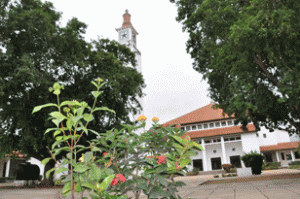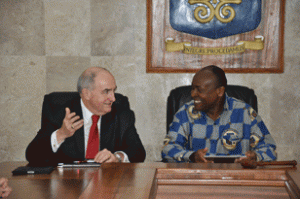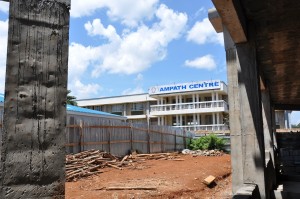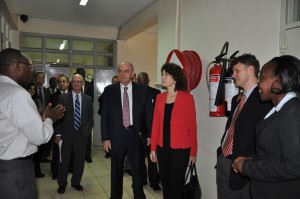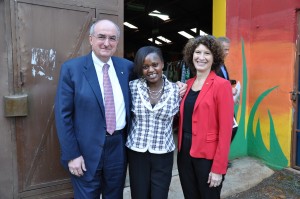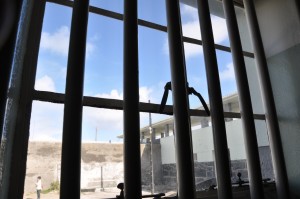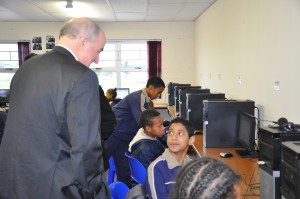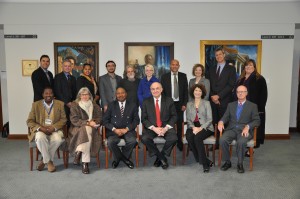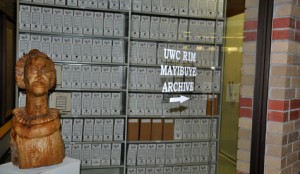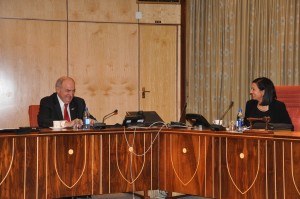Once a Hoosier, always a Hoosier, in Ghana
“Indiana University was, for me, an experience never to be forgotten.”
“I hope there will one day be another opportunity for me to go back to Bloomington.”
“I will always be a Hoosier.”
The final day of this historic IU presidential trip to Africa offered delegation members a chance to meet and talk with five faculty members at the University of Ghana, all of whom were once the beneficiaries of IU scholarships to study in Bloomington.
As each faculty member took turns telling his or her story before IU President Michael McRobbie, the first IU president ever to visit Ghana, it was impossible not to be struck — as delegation members have been at each stop on their journey — by IU’s remarkable impact here in sub-Saharan Africa, what the university has meant to so many African students throughout the years and the promise of IU’s increasing engagement in this dynamic part of the world.
Kodzo Gavua is a senior lecturer in the Department of Archaeology and Heritage Studies at the University of Ghana, Ghana’s oldest public university and an institution with more than 36,000 students. Through a student-exchange agreement between IU and UG, Gavua had the opportunity to come to IU in 2002 and spend a year working alongside faculty members in IU’s departments of anthropology and folklore and ethnomusicology. While at IU, he also sought instruction in computer literacy, music and basic studio engineering, and he even learned how to play West African percussion. Folks back home in Bloomington might remember him as the leader of the popular “Afro Hoosier Intl” dance band.
In 2009, Emmanuel Asampong was a visiting scholar in Bloomington, where he had the opportunity to assist in research on HIV being conducted by IU Bloomington School of Public Health Associate Dean Michael Reece and his team at the Center for Sexual Health Promotion. Today, he is a clinical psychologist and lecturer at UG’s school of the same name. While at IU, he helped link IU public health students and with students in Ghana who were studying similar topics. These online discussions, he said, addressed numerous misconceptions about Africa and helped prevent IU students from generalizing research findings about one country (Kenya, for example) to the whole of the continent.
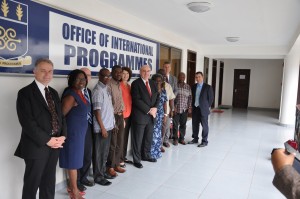
The IU delegation poses with University of Ghana faculty members who were once the beneficiaries of IU scholarships to study in Bloomington.
If you needed to find Alexina Arthur during her time in Bloomington in 2002, you would have been well served to start in the Wells Library. The senior lecturer in the UG’s Department of Modern Languages and scholar of Russian literature says she spent the majority of her time at IU (time, she says, that was far too short!) devouring countless books and scouring newspaper archives documenting Russian-African relations when she wasn’t helping her daughter adjust to life and academic expectations as a Bloomington middle-school student.
“Indiana University has been very critical in the life of this university and in developing our faculty,” UG Pro-Vice Chancellor E. Kweku Osam told members of the IU delegation during a meeting in which leaders from both schools discussed ways to expand a partnership between IU and UG that dates back two decades and has generated numerous student and faculty exchange activities.
Indeed, IU had deep ties to Ghana, where more than 100 IU students studied abroad last year. Additionally, more than 20 students from Ghana were admitted to IU this fall.
Pro-Vice Chancellor Osam, who did his undergraduate work in linguistics at UG with Samuel Obeng, director of IU’s acclaimed African Studies Program, proudly mentioned that three current UG linguists received their training at IU.
In 2011, the IU Kelley School of Business’ innovative Global Business and Social Enterprise (GLOBASE) began sending Kelley MBA students to the country to act as business consultants to local entrepreneurs.
IU’s Mathers Museum of World Cultures has multiple ties to Ghana scholars. Most recently, IU art history graduate student and Mathers collaborator Brittany Sheldon, who is currently in Ghana, has developed an exhibition based on her research on traditional decoratively painted houses. Her exhibition, State of an Art: Contemporary Ghanaian Bambɔlse, will be presented this fall at the Ghana Museums and Monuments Board.
All in attendance at the meeting agreed that there was room to strengthen and expand the ties between their respective universities, particularly in areas in which IU’s strengths — including those in African language instruction, information technology and public health — align themselves with UG’s mission to enhance its research profile, increase its number of graduate-level students and become a more international university.
Not surprisingly, the meeting covered a great deal of common ground. It even produced a few interesting revelations, such as when UG’s Dean of International Programs Naa Adamafio told IU delegation members that her university currently boasts Africa’s best program in African studies, leaving the perfect opening for President McRobbie.
“So this means we both have the best programs on our respective continents!” McRobbie said, elicting a hearty laugh from the dean and her colleagues and ending the meetings at UG on a most positive note.
***
And so, a productive, memorable and inspiring presidential trip to South Africa, Kenya and Ghana comes to a close. I hope to recap some of the many highlights of this historic trip in the coming days, once the jet lag has subsided and we’ve all had a little time to reflect on the people we met, the places we were and the great potential we all were able to feel and experience in this amazing part of the world, one in which IU promises to be increasingly engaged in the years to come.
Until then, as they say in Kenya, asante sana!
Thank you very much for reading!
Tags: Accra, Africa, African Studies Program, Alexina Arthur, Brittany Sheldon, E. Kweku Osam, Emmanuel Asampong, Ghana, GLOBASE, Indiana University, IU, Kenya, Kodzo Gavua, Mathers Museum, Michael McRobbie, Michael Reece, Naa Adamafio, School of Public Health, South Africa, UG, University of Ghana
Goodbye, Kenya. Greetings, Ghana.
Members of the IU delegation said goodbye to Kenya early this morning, but not without taking with them an indelible impression of a country that, in many ways, reflects both the dynamism and tension felt here in Africa, the world’s second-largest and second-most-populous continent, but also its poorest and most underdeveloped.
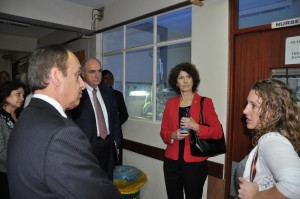
IU delegation members speak with a faculty member outside a new neonatal nursery at the AMPATH Center in Eldoret, Kenya.
About half of those who live in sub-Saharan Africa are living in poverty, and the average poor person makes less than $1 a day. When you consider the massive health care challenges facing the region, including widespread HIV/AIDS, the situation in Africa seems staggeringly dire.
That said, there was great reason for hope in Eldoret, Kenya, where the historic AMPATH project has become one of the largest academic centers for the treatment of HIV/AIDS in the world since its founding more than two decades ago. Following a “lead with care” model championed by its co-founders, doctors Joe Mamlin and Bob Einterz, AMPATH has, in recent years, broadened its scope and mission to include other areas critical to Kenyans’ survival, including food and income security and non-communicable chronic diseases such as heart disease, hypertension, diabetes and cancer, that pose a health threat projected to far exceed that of HIV in sub-Saharan Africa.
There is no denying the great despair at the AMPATH Center/Moi Teaching and Referral Hospital, which IU President Michael A. McRobbie, the first IU president to ever visit the program, had the opportunity to tour earlier this week. The images — of crowded medical wards, sad faces, children exposed to and possibly infected with HIV, and bottles of medications stacked in a pyramid-shaped pile 10 rows high — won’t be soon forgotten.
But neither will the pride that members of the IU delegation felt after meeting and talking with the many IU faculty and students in Eldoret who are having a dramatic impact in saving Kenyans lives. To hear directly from them — and from their Kenyan colleagues at Moi University — about what the AMPATH project has meant to them, and to experience, first-hand, a program that now serves 3.5 million people in over 500 urban and rural clinical sites throughout western Kenya is incredibly emotional and uplifting.
Indeed, it’s impossible not to admire the amazing progress taking place at AMPATH, through the marvelous dedication of its faculty and staff, which is reflected in a new state-of-the-art neonatal area; a child-life center that warmly caters to sick and orphaned children; new safety-net interventions and vulnerability assessments and an oncology department that started from next to nothing and will soon be housed in a new Chronic Disease Building, which will open in 2015. Equally impressive is the work AMPATH staff are doing to reach people, some of whom have never received any type of medical care, in small, rural villages in the outer reaches of Eldoret — villages such as Mosoriot, where delegation members were welcomed into an elderly woman’s home and watched, along with her daughters and two young grandchildren, as a young Swahili-speaking counselor administered a diabetes and HIV test. The test, thankfully, was negative, so delegation members and their newfound friend celebrated over tea, a kind of sour milk and grilled maize.
It was also fascinating to hear about work being done to improve and expand AMPATH’s Open Medical Record System, which was designed to confront one of the most vexing challenges of health care systems in Africa: the transition of outdated paper-based registries into electronic medical records responsive to the needs of patients, providers, donors and government. AMPATH physicians and informational technology staff are working together to realize the promise of a large-scale electronic medical records system for Kenya, where electricity has become more widely distributed, Internet access is available and the majority of the country’s citizens now have cell phones. If they are successful (no easy feat), an expanded OpenMRS could potentially revolutionize the way health care is conducted in Africa and around the world.
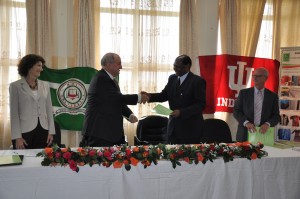
IU President Michael A. McRobbie shakes hands with Moi University Vice Chancellor Richard Kiprono Mibey after signing a new partnership agreement between their respective universities.
And then there was the signing of a new partnership agreement with Moi University, which McRobbie said will “elevate” IU’s relationship with Moi to the university level and ensure expanded collaboration in academic disciplines across both universities — including in areas such as dentistry, nursing and medicine, which Moi leaders say they would not have been able to launch without the help of IU colleagues; but also in newer areas such as mass media, a rapidly growing industry in Kenya. As a graduate of the IU School of Journalism, I took great personal pride in IU formalizing an agreement with Moi’s Department of Communications, an agreement built on the foundation set by a successful exchange program where IU journalism students work side by side with their Moi counterparts and report on, among other topics, the great work being done at AMPATH.
So now it’s on to our final stop, Accra, Ghana, where members of the delegation will meet with IU alums here, site of the university’s first-ever study abroad program, and explore new collaborations with leaders at the University of Ghana, the country’s oldest university. It’s sure to be an educational last leg of this most productive and inspiring presidential trip.
Tags: Africa, AMPATH, Eldoret, Ghana, IU School of Journalism, Kenya, Michael McRobbie, Moi Teaching and Referral Hospital, Moi University, Mosoriot, Richard Kiprono Mibey, University of Ghana
The IU-Moi impact
Members of the IU delegation barely had time to process all of the amazing work they had seen and heard about at the AMPATH Center here in Eldoret, Kenya, when they were shuttled off early this morning for a visit to IU’s co-founding partner in the path-breaking project, Moi University.
Yesterday’s tour of the AMPATH Center and Moi Teaching and Referral Hospital had been far more enlightening, uplifting and inspiring than could ever have been imagined before the delegation’s arrival in Kenya. And yet the day, which included an overview of the program, visits to more than a dozen medical wards, clinical sites and other hospital units, and informational sessions with numerous key physicians and staff, had also been exhausting, emotionally draining and, at times, extremely sobering, despite all of the program’s well-documented successes.
Still, the spirit of the AMPATH staff was so great, and their dedication to saving the lives of Kenyans so overwhelming, that it kept us energized entering the gates of Moi University, where we were greeted by a rousing performance by the Moi University Choir, which has won numerous choir awards in Africa and has performed at many university and state functions.
After IU President Michael A. McRobbie thanked the group for its warm musical welcome, he and other members of the delegation were introduced to Moi’s senior management team, led by Vice Chancellor Richard Kiprono Mibey, who was delighted to receive his guests and even more thrilled to express his appreciation for IU and what it has done to develop Moi University.
Moi University started in 1984 as Kenya’s second public university with a first class of 83 students and just one faculty member. Today, it has more than 30,000 undergraduate and postgraduate students and four campuses, including the main campus in Eldoret and another in the western part of the town. Moi also boasts 14 schools, including newly established schools of aerospace science, biological and physical science, and tourism, hospitality and event management.
Among its more established units are the Schools of Dentistry, Nursing and Medicine, which, as Vice Chancellor Mibey and other Moi leaders were quick to point out, would not have been possible without the support of IU. As a result of the AMPATH project, which began in the late 1980s as a way to initiate collaborative activities between IU and Moi, these schools have partnered with IU on a number of service learning and faculty exchange programs that have helped them grow into some of the best academic programs in Kenya. Take the School of Dentistry, for example. Moi attempted to launch the school in 1998 but was unsuccessful. As the IU-Moi partnership continued to grow, though, the school was re-launched, this time successfully. Today, more than 34 million Kenyans rely on the dentistry services connected to Moi, according to Vice Chancellor Mibey.
Additionally, as AMPATH has expanded its model of care beyond the treatment and prevention of HIV/AIDS to inextricably linked areas critical to Kenyans’ survival, including food and income security and non-communicable chronic diseases in sub-Saharan Africa such as heart disease, hypertension, diabetes and cancer, Moi’s academic resources have become even more essential to enhancing in a major way the research enterprise at the AMPATH Center and Moi Teaching and Referral Hospital.
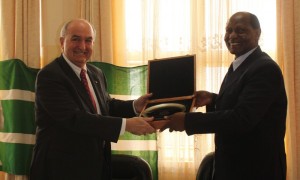
IU President Michael A. McRobbie presents the International Service Award to Moi University Vice Chancellor Richard Kiprono Mibey.
To ensure the continued impact of this decades-long collaboration, IU President McRobbie and Vice Chancellor Mibey signed a new IU-Moi partnership agreement that will fully elevate IU’s relationship with Moi to a larger university level. Additionally, the two leaders inked a sub-agreement between the IU School of Journalism and the Moi Department of Communications, a program that has experienced major growth in correlation with one of Kenya’s fastest-growing industries, mass media. Today, Kenya has several major newspapers and TV networks that are seeking skilled media professionals who can report on complicated national, including democratic politics and business, for a population of more than 40 million people who are increasingly connected through massive cell phone usage.
The agreement between the IU School of Journalism and the Moi Department of Communications will build upon an immersive student reporting project in Kenya established several years ago by IU professor Jim Kelly. In each of the past three years, Kelly has brought a group of 12 IU students to Eldoret to report on AMPATH’s HIV/AIDS treatment and other health care efforts and learn about Kenyan culture by partnering with Moi students. The IU students who traveled to Kenya in June published their reporting online at a special website devoted to the project.
On the Moi side, more than 40 of Kenya’s leading media personalities have come through the university, say school leaders, who are also building their own TV station, as part of Kenya’s national platform, to serve as training ground for new journalists.
After the agreement signings, there was just one more ceremonial matter of business: a surprise presentation by McRobbie of the prestigious International Service Award to Vice Chancellor Mibey for his outstanding contributions to advance the mission of IU through its expanding partnership with Moi. Then it was off to one of Moi’s newest and most promising projects: a large, fully functioning facility engaged in the production of textile products. In the late 1980s, all of Kenya’s textile factories shut down — more than 40 in total — leaving thousands without jobs. Today, Moi leadership hopes that the Rivatex East African Limited facility will provide the necessary training, research and product development to revive one of the country’s oldest industries.
The facility was a most impressive site and another example of the major impact Moi has had — and will continue to have — in Kenya in the years to come and with IU standing by its side.
Tags: AMPATH, Communications, Eldoret, Indiana University, IU, IU School of Journalism, Kenya, Michael McRobbie, Moi University, Richard Mibey, Rivatex, Textiles
‘We can do this — ourselves’
You read about it and hear about it, digest the facts and marvel at the statistics, but it’s an entirely different experience seeing and experiencing, first-hand, the AMPATH project here in Eldoret, Kenya. That might sound cliché, or maybe even trite. But there’s truly no other way to put it into words what it’s like touring this legendary program that has had such an astounding impact on millions of people in Kenya.
The history of the Academic Model Providing Access to Healthcare program is well documented but also well worth repeating. Conceived in the late 1980s by four IU physicians (Bob Einterz, Joe Mamlin, Charlie Kelley and Dave Van Reken), each of whom had experience in developing countries and a view that they could help better the lives of people around the world, the program took root as a full-fledged program in 1990, initially intended to link faculty and resources at the IU School of Medicine with the fledgling Moi University Faculty of Health Sciences — later to be renamed the Moi University School of Medicine. Just over a decade later, with 20 million Africans estimated to be infected with HIV, the virus that causes AIDS, the leaders of AMPATH would make a deliberate, one might say dramatic, decision to tackle the HIV pandemic in western Kenya.
Today, AMPATH, a partnership among IU, Moi University and the Moi Teaching and Referral Hospital, is one of the largest and most comprehensive academic centers for the treatment of AIDS in the world. Nominated multiple times for the Nobel Peace Prize, the program serves a population of 3.5 million people in over 500 urban and rural clinical sites throughout western Kenya and has enrolled more than 160,000 HIV-positive people.
AMPATH approaches the complex challenges of improving the health of Kenyans with a simply stated philosophy: Lead with care. This philosophy has demanded that the program’s leaders apply what they have learned in developing a successful system for treating HIV/AIDS into other areas critical to Kenyans’ survival, including food and income security and non-communicable chronic diseases in sub-Saharan Africa such as heart disease, hypertension, diabetes and cancer that are projected to far exceed that of HIV.
Throughout its development, AMPATH has also provided an opportunity for many of IU’s medical students, as well as students in the university’s School of Nursing and a number of other health science-related schools to gain vital real-life experience integral to their training. More than 1,000 American and Kenyan medical students and residents have participated in the program, which, in recent years, has received generous support from USAID, the United States Agency for International Development, as well as generous donors from Indiana.
Today was a historic day for AMPATH as IU President Michael A. McRobbie became the first IU president to visit the program since its inception, a monumental occasion not lost on one of its founders, Dr. Joe Mamlin (“call me ‘Joe'”), who possesses a bit of rock star status here in Eldoret, but with absolutely none of the pretensions. The evening before McRobbie and members of the IU delegation were scheduled to tour the AMPATH project, Dr. Mamlin (sorry; Joe) expressed how grateful he — “an old hillbilly from North Carolina” who has been at IU for more than five decades — was for the opportunity to host the president of a university that gave life to AMPATH and, in the course of doing so, hundreds and thousands of Kenyans.
That feeling of pride permeated an early-morning meeting at AMPATH, where program leaders, including program director Sylvester Kimaiyo, and his colleagues, Director of Moi Teaching and Referral Hospital John Kibosia and Fabian Esamai, principal of the Moi University College of Health Sciences, took turns expressing their gratitude to IU and their reflections on the program’s astounding success.
“I do not think I would’ve started an HIV program without the braveness and support of my colleagues at IU,” said Kimaiyo, who told a funny story about learning how to do email while studying in one of the infectious disease units at the IU School of Medicine. “It was thought that you couldn’t start an HIV hospital in Africa. Just impossible. But we did it. We started it. And now we are one of the biggest HIV programs in the world.”
From this initial meeting, Kimaiyo, Mamlin, Bob Einterz and IU executive field leader Adrian Gardner, who became involved with the program when he did his first rotation as a medical student in 2001, led McRobbie and members on the delegation an equal parts stunning and sobering tour of the impressive Moi Teaching and Referral Hospital and AMPATH Center — from the registration center where patients are first admitted to the pharmacy, labs, legal center, data center, medical and pediatric wards, and cardiac care unit, among several other areas, where medical staff from IU, Moi and other partnering institutions work together to treat suffering patients, many of whom would have no chance for survival if not for the AMPATH clinic.
The stories the IU delegation heard in each of these areas were often times staggering and accompanied by sights and sounds that enhanced their impact. Rachel Vreeman, a pediatrician in the Department of Pediatrics at the IU School of Medicine and one of the co-directors for the research field program for AMPATH, spends about half of the year in Kenya, seeing patients and conducting research that she hopes will children’s health care in western Kenya. She explained to McRobbie that the pediatric clinic at the AMPATH Center will average 100 children a day who have been exposed to HIV/AIDS. Roughly half of those children will contract the virus. In contrast, the entire state of Indiana will see 50 HIV/AIDS-infected children in an entire year, she said. (Vreeman’s blog chronicles her time at AMPATH.)
Just getting children to an AMPATH clinic is a huge achievement, Vreeman and others added, as the costs and stigma associated with having a child with HIV causes many families not to seek treatment. Likewise, in the neo-natal clinic and pharmacy, where bottles of medication were stacked up in a massive pile, stories were told about patients who no longer take their prescriptions because, in some cases, a dosage might cost more than their monthly salary.
And yet there were also stories of incredible progress and potential. As they walked through several treatment wards, members of the IU delegation learned that more and more Kenyans were getting early treatment due to early detection efforts, increased disclosure so that children are told of their HIV status (research indicates that only 11 percent of Kenyan children know whether they are carrying the virus), supportive counseling activities to help erase the stigma of HIV and retention efforts. AMPATH leaders believe that one of its main program pillars, called Find, Link, Treat and Retain, or FLTR, can ultimately create a new, HIV-free generation in Kenya.
In the data center, delegation members learned about transitioning from ragged scraps of paper records to new, high-tech records systems, advanced by researchers at IU and the Regenstrief Institute at IUPUI, with close to 700,000 individuals in them and more than 4.5 million visits.
In the Sally Test Center, a child-life center located within the hospital wards that caters to sick and abandoned children, the young patients and their caregivers happily sang a hello song to their visitors, including to IUPUI Executive Vice Chancellor Nasser Paydar, who is accompanying the delegation on the Kenya portion of its Africa tour.
Toward the end of the tour, delegation members donned hard hats to view what will soon become a new, four-floor, high-efficiency Chronic Disease Building, fueled in part by solar power and scheduled to open in 2015. The building will contain outpatient clinics, research space, classrooms and seminar rooms, and it represents a critical component of AMPATH’s strategy to control and prevent a wide range of chronic, non-communicable conditions and diseases.
And then there was Njoki. In 2002, Njoki was pregnant when a pre-natal exam revealed she was HIV-positive. Left by her husband and alone on the streets of Eldoret with the stigma of HIV, she found her way to AMPATH, where she eventually learned to string beads into ribbons and necklaces that she was encouraged to sell. Today she is production manager of the Imani Workshops, established in 2005 to provide job training and income-generation activities for those affected by HIV and others in need. The group now employs more than 100 members and sells jewelry, bowls, stationary, bags and other items, with 100 percent of the income earned through the sales revenue reinvested in the workshops.
At the end of telling her inspirational story, Njoki spoke proudly of coming to IU and to the Herron School of Art and Design at IUPUI, where she received several months of training. “So now,” she laughed, “ I, too, can say that I am a member of IU.”
Indeed, she would have been right at home when, during a lunchtime gathering held in between activities at AMPATH, President McRobbie formally recognized the Kenya chapter of the IU Alumni Association as the university’s newest official alumni community.
In remarks to about 100 IU Kenyan alumni, McRobbie talked about AMPATH and the transformative power of education and research in action. The wide-ranging collaboration, he added, proves the truth of an African proverb, “Partnership must be more than a word. It must be a behavior.”
Joe Mamlin has a similar saying, referring to the heroic work being done here in Eldoret, which several AMPATH staff repeated today: “We can do this — ourselves.”
After today, it was easy to see the truth in those words, too, and feel pride in IU’s role in launching the miraculous AMPATH program.
“I’m absolutely proud I’m from Indiana University,” Mamlin said last night. “This is a program that’s different from any collaborative program anywhere in Africa. The struggle here is to be a part of doing something that’s meaningfully different for entire populations instead of just having a fun clinic to teach or do a research project.
“And, you know what, it’s all because of Indiana University. I can’t think of any school I’d rather be identified with.”
Tags: Adrian Gardner, Africa, Aids, AMPATH, Bob Einterz, Eldoret, Fabian Esamai, Herron School of Art and Design, HIV, Imani Workshops, Indiana University, IU, IU School of Medicine, Joe Mamlin, John Kibosia, Kenya, Michael McRobbie, Moi University, Nasser Paydar, Rachel Vreeman, Sylvester Kimaiyo
Robben Island and the South African spirit of resilience
It’s almost impossible to put into words what it’s like to walk around Robben Island, an island about three miles west off the coast of Cape Town, where Nelson Mandela was imprisoned for 18 of his 27 years behind bars during South Africa’s apartheid era.
One could describe the 8-foot-by-8-foot jail cells where Mandela and many other political prisoners, including South Africa’s current President Jacob Zuma, were held captive, the solitary confinement areas, the lime quarry where inmates worked their hands to the bone, but it would simply not give this historic setting its proper due.
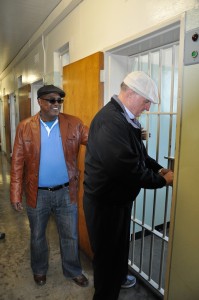
IU President Michael A. McRobbie unlocks the Robben Island jail cell where Nelson Mandela was imprisoned for 18 years, as former inmate Sipho Msomi looks on.
That said, there may have been no more fitting final stop to this Indiana University presidential trip to South Africa than Robben Island which, despite serving as a sad and stark reminder of so much tragedy and sacrifice, also manages to reflect a spirit of pride and resilience in the face of great challenges that gives South Africa such a special identity in Africa and around the world.
Coincidentally (or maybe not so much considering IU’s many South African connections that have surfaced this week!), Robben Island’s CEO is Sibongiseni Mkhize, who spent eight weeks studying at IU Blomington in 2001 as part of an African Studies summer program and who met with members of the IU delegation during a special alumni dinner earlier this week. (Watch “Sibo” talk about the living museum that is Robben Island in a recent Cape Town TV interview.)
When Sibo found out the IU delegation was coming to South Africa, he arranged a special tour, led by Sipho Msomi, a former Robben Island inmate. Sipho was arrested by the South African police in 1984 when he was only 20 years old, along with five other young organizers for the African National Congress. One of those organizers, he said, was tortured to death.
Sipho spent four of his five years in prison at Robben Island. Today, he leads tours of the island, recounting his and other prisoners’ tales of sacrifice, while giving his guests a strong sense of how the island has been transformed into a beacon of African pride and spirit.
Sipho took us to the jail cell where Mandela was imprisoned and slept on the cold stone floor, often with just a thin blanket to protect him from the island’s often frigid temperatures. He also showed us to the courtyard where inmates gathered, talked about the cement bags and toilet paper that Mandela and others could sometimes use as writing surfaces and brought us to the solitary confinement area where he, himself, spent 10 months.
Sipho then sent us off on a short bus ride to another area of the island, where Robert Sobukwe, who became president of the Pan-Africanist Congress in opposition to apartheid in 1959, spent six years in solitary confinement, his imprisonment renewed annually by the Minister of Justice in a procedure that became known as the “Sobukwe clause.” The clause was never used for anyone else, and Sobukwe, who lost the use of his vocal chords while at Robben, was ultimately held under house arrest by the national government until his death in 1978. Before his death, though, he earned a degree in economics from the University of London.
Finally, it was on to the lime quarry where Mandela and others were sent to work until their hands blistered and bled. The barren quarry, which wouldn’t be out of place back home in Bloomington, Ind., could’ve simply been a place of great hardship. Instead though, it was transformed, through education, into a place of hope. Here, at what became known as “Robben Island University,” many of South Africa’s most prominent prisoners at the time, including Mandela, engaged in discussions and debate over a wide range of topics, including democracy, socialism, political protest movements and more.
When President Barack Obama visited Robben Island back in June, he and First Lady Michelle Obama signed a guest book, writing, “On behalf of our family we’re deeply humbled to stand where men of such courage faced down injustice and refused to yield. The world is grateful for the heroes of Robben Island, who remind us that no shackles or cells can match the strength of the human spirit.”
As members of the IU delegation prepare to leave tomorrow for their next stop (Kenya), they won’t soon forget the spirit of South Africa, as they look forward to new partnerships here that stretch the minds of IU students who will study abroad here, help this wonderfully dynamic nation seize the many opportunities before it and keep alive the flame of “Robben Island University.”
Tags: apartheid, Indiana University, IU, Jacob Zuma, Michael McRobbie, Nelson Mandela, Obama, Robben Island, Robert Sobukwe, Sibongiseni Mkhize, Sipho Msomi, South Africa
Transforming lives in Cape Town
Unfortunately, the IU delegation brought with it to Cape Town a bit of bad weather, including cloudy skies, rain and brisk temperatures in the low 50s. (Of course, I’m guessing that heat-stricken Hoosiers would happily take those temperatures right now!)
That said, any weather-related blues that delegation members might’ve been feeling were quickly washed away this morning, not by the rain, but by the smiles on the faces of the children of Christel House South Africa.
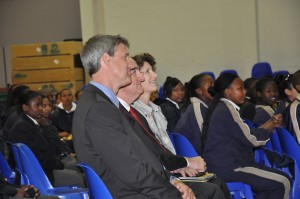
Senior Director of International Alumni Eric DeHaan, IU President Michael A. McRobbie, IU first lady Laurie Burns McRobbie watch students perform at Christel House South Africa.
For those who may not know it, Christel House was founded by Indianapolis philanthropist Christel DeHaan to help children around the world overcome poverty and realize their hopes and dreams. Here in South Africa, Christel House (which also has centers in India, Mexico, the U.S. and Venezuela) is transforming lives by providing more than 700 K-through-12th-grade children from some of Cape Town’s most impoverished communities with a quality education, as well as proper nutrition, health care and a safe, nurturing environment.
Indeed, the numbers reflect the remarkable success of Christel House South Africa. They include a 100 percent graduation rate over the last four years, a 99 percent retention rate and a 98 percent attendance rate. Christel House achieved these results while enrolling its entire student body from severely disadvantaged communities, transporting those students to and from school, feeding them several meals each day and providing support to children and their families facing a wide range of socio-economic challenges, including neglect, domestic violence, physical and sexual abuse, and gang violence, to name just a few.
Impressive as those statistics are, they are no substitute for seeing these amazing students, all fully uniformed and full of energy, in their learning environment. Following an instructive and insightful meeting with the school’s leadership, IU President Michael A. McRobbie and first lady Laurie Burns McRobbie were escorted to the front of a large assembly hall, where the entire Christel House student body, teachers and staff had gathered to welcome their Hoosier guests. Once seated, they were treated to a rousing performance by the school band, several sing-alongs and a spirited step-show. In the middle of these performances, a teenage girl confidently strode up to the stage to introduce President McRobbie and invite him to say a few words. Given a microphone, McRobbie told the attentive students about the importance of education, how inspired he was by their accomplishments and how he hoped that, one day, they might even continue their studies at IU.
After the assembly gathering, McRobbie and members of the delegation were given a walking tour of the school’s impressive facilities, including a fully stocked library where a trio of young boys flipped through a book about soccer and a Dell-furnished computer lab where McRobbie enjoyed putting on his IT hat and chatting with several young children about email, spreadsheets and word processing. From there, it was off to Cape Town’s oldest township and one of the communities served by Christel House, Langa. Established in 1923, Langa is one of the many areas in South Africa where blacks were forced to live before the apartheid era. The location of much resistance to the national ruling system of racial segregation that dominated South African society for nearly five decades, it has had a long, sometimes tortured history—a history that was eloquently recounted by our tour guide, a young Langa resident and former Christel House student named Oowa.
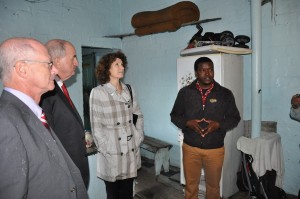
Members of the IU delegation receive a tour of the Langa township from Oowa, right, a community resident and former Christel House student.
Oowa, whose desire to be a professional tour guide was inspired by his time at Christel House, was candid about the many challenges facing Langa, including crime, poverty, unemployment and severely constrained living accommodations (he, himself, shared an approximately 10-foot-by-10 foot bedroom with three other families). At the same time, he spoke proudly of the positive changes he felt were taking place in his community, while challenging his own generation to learn more about those who sacrificed before it in the struggle against apartheid.
Christel House provided a most interesting model of education and inspiring lead-in to the next stop on the delegation’s journey through South Africa: the University of Cape Town, Africa’s top-ranked university and the oldest university in South Africa, founded in 1829 as the South African College.
Nestled in the breathtaking slopes of Devil’s Peak mountain, UCT boasts top-ranked programs in a number of areas, including business, economics, education, geography, history, law, psychology and politics. It also counts five Nobel Laureates among its alumni.
Enrollment at UCT continues to grow—by a third each decade since 1950. Today, the university has over 25,000 students, half of whom are black, and it now has over 110,000 alumni around the world.
Despite its strengths and successes, UCT has come to a realization, according to Deputy Vice Chancellor of Internationalization Thandabantu Nhlapo, that the university can no longer separate its strong academic and research enterprise with a need to produce graduates who are internationally competitive and committed to engaged citizenship and social justice.
To this end, Nhlapo and his UCT colleagues were happy to hear President McRobbie share IU’s mission of increased internationalization and signal the university’s willingness to explore the possibility of student exchanges and faculty research collaboration, especially in subject areas in which both universities have strengths.
Prior to the meeting, the IU delegation sat down for coffee with two IU students, Luke Vroom and Lauren Miller, studying at UCT this semester. Both described how enjoyable their experience at UCT has been and said they would encourage more students to consider coming to Cape Town, where they were struck by the amazing diversity, history and beauty of the natural surroundings, to study.
UCT Deputy Vice Chancellor Sandra Klopper, who is also a professor of African art, suggested there may be potential for collaboration in the arts, law, music and the natural sciences, among other areas, adding with a laugh, “You know, I think more than half of my colleagues in African art received their training at IU!” Klopper’s comments came right after Harold Kincaid, a professor from the UCT School of Economics, introduced himself to the delegation by telling the group that he possessed a total of three IU degrees.
While no specifics were agreed upon just yet, both sides agreed that, as a next step, they would explore a number of specific areas for potential collaboration and cooperation. And it was clear that leaders of both schools were on their way to more productive discussions down a path toward more opportunities for future generations of students, both in the U.S. and here in South Africa, including, just maybe, someone like Oowa or another of the amazing kids at Christel House.
Tags: apartheid, Cape Town, Christel DeHaan, Christel House, Indiana University, IU, Langa, Michael McRobbie, Sandra Klopper, South Africa, Thandabantu Nhlapo, UCT, University of Cape Town
Lessons of the past, promises of tomorrow
As members of the IU delegation met with senior leaders this morning at the University of the Western Cape—a public university located in the Belleville suburb of Cape Town, South Africa—it was next to impossible, at least from this observer’s vantage point, not to marvel at a most timely juxtaposition.
Just a few hours prior to the trip to UWC, President Barack Obama delivered remarks from the steps of the Lincoln Memorial commemorating the 50th anniversary of the historic March on Washington and the heroism of its leader, Dr. Martin Luther King Jr. In his address, Obama spoke about the spirit of the march and the sacrifices made by thousands of Americans, “men and women, young and old, blacks who longed for freedom and whites who could no longer accept freedom for themselves while witnessing the subjugation of others.”

IU President Michael A. McRobbie, right, and University of the Western Cape Deputy Vice Chancellor Ramesh Bharuthram discuss possible collaborations between their universities.
Three years before the March on Washington and halfway across the world, the South African government, seeking to racially segregate higher education under the system of apartheid, established the University of the Western Cape as a school for colored students only. (Its first group of 166 students were given limited training for lower- to mid-level positions in schools, the civil service and other institutions that would serve a separate colored community.) UWC would remain this way several decades, during which its leadership was primarily white.
As UWC continued to grow, so, too, did the campus’ intellectual and innovative spirit, much of which became focused on making the university freer and more democratic. By 1982, UWC’s leadership had formally rejected the apartheid ideology on which it was established, and a year later the university had gained autonomy on the same terms as established white institutions.
With the official abolishment of apartheid in 1994, UWC had made a major contribution to what Dr. King’s South African and spiritual counterpart, Nelson Mandela, and other political activists in the country had long fought and sacrificed—the creation of a new democratic order. What’s more, it had rapidly become one of the nation’s top research institutions and a major player in the formation of public policy and preparing South African students for a wide range of high-level careers.
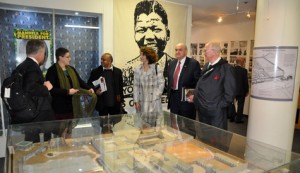
The IU delegation looks at a model of Robben Island at the University of the Western Cape-Robben Island Mayibuye Archives. The archives contain many records that document the apartheid period, the freedom struggle and political imprisonment in South Africa.
Ironically, though, UWC had been so successful in bringing about change that when Mandela became president, in 1994, he took with him nearly a third of the university’s leadership team (including its president) to build his cabinet. Today, UWC’s current leadership, with whom members of the IU delegation met today, refers to the loss of that talent as “brain drain,” another interesting juxtaposition when one considers the term’s connotations as they apply to higher education in the U.S.
The draining of intellectual assets at UWC came at a critical time for the university, which, to this day, continues to deal with the tension of dealing with a country where poverty affects around 85 percent of the total population. But the university has responded quite well. Over the last two decades it has experienced an enormous amount of growth as it has strategically aligned its teaching, learning and research resources with South Africa’s greatest challenges.
At today’s meetings, the leadership of UWC, which now has an enrollment of more than 20,000 students, expressed an eagerness to continue to confront those challenges, while growing its own international relations with universities that have complementary missions and strengths. To this end, leaders from both IU and UWC agreed that they are academically well matched, most notably in such key areas as education, the life sciences and the arts and humanities, and that they would seek ways to further student and faculty exchanges between their respective institutions.
Particularly intriguing to IU President Michael McRobbie and Vice President for International Affairs David Zaret, who has served as interim dean of IU’s College of Arts and Sciences on two separate occasions, was UWC’s focus on renewing the humanities in South Africa. As UWC Deputy Dean and Director of the Center for Humanities Premesh Lalu passionately explained, UWC is eager to build partnerships in the area of creative activity, which, sadly, apartheid denied to most of South Africa’s population.
After the formal meeting ended, McRobbie, Zaret and other members of the IU delegation got a first-hand look at how UWC is recharging creative activity on campus and engaging students in important cultural, historical, political and social conversations that South Africans need to succeed in rising above some of the problems plaguing the country, most notably extreme poverty.
UWC’s Lalu led delegation members on a tour of UWC’s impressive collection of archival materials related to Robben Island, the island off the coast of Cape Town where Mandela and other anti-apartheid activists were imprisoned and where the IU contingent hopes to visit later this week, weather-permitting. The UWC-Robben Island Mayibuye Archives, through which the Robben Island Museum was launched, is the leading archive in South Africa with 100,000 photographs, 10,000 film recordings, 5,000 island artifacts, 2,000 oral history tapes and 2,000 posters, as well as 10,000 political cartoons, that document the terrible torment so many South Africans faced in the fight for freedom and equality.
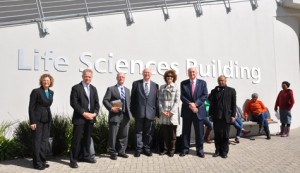
The IU delegation outside the Life Sciences Building at the University of the Western Cape. Members were joined by Dean of Research Renfrew Christie, center, and Premesh Lalu, right, who is Director of the Centre for Humanities Research.
The IU delegation didn’t have to look very far for a real-life example of that struggle in UWC Dean of Research Renfrew Christie, a classmate of IU’s David Zaret at Oxford during the 1970s. It’s worth noting that Christie is white, is an accomplished academic and has about the friendliest face you’re likely to meet. The former student leader at the University of Cape Town also spent seven years in prison, some on death row and some in solitary confinement, jailed by the apartheid government for spying on the nuclear weapons program for the African National Congress, which, amazingly enough, is now the ruling party of post-apartheid South Africa.
The delegation will get to meet with Christie again tomorrow, and when we do I’ll likely be thinking of Obama’s speech again and his concluding words, which, in one final juxtaposition, might just as well apply to this amazing country that we continue to explore.
“That’s the lesson of our past. That’s the promise of tomorrow—that in the face of impossible odds, people who love their country can change it.”
Tags: apartheid, Barack Obama, Cape Town, David Zaret, Indiana University, IU, March on Washington, Martin Luther King Jr., Mayibuye Archives, Michael McRobbie, Nelson Mandela, Premesh Lalu, Renfrew Christie, Robben Island, South Africa, University of the Western Cape, UWC
IU’s South African connections run deep
As the IU delegation leaves behind sunny and mild Johannesburg for rainy and cool Cape Town, it gives me a moment to reflect on a number of interesting IU-South Africa connections that I’ve picked up both before and during this presidential trip.
Almost every South African we’ve talked to thus far—whether it be the administrators and faculty at the Gordon Institute of Business Science in Johannesburg or South Africa’s minister of higher education and training, whom we met yesterday in Pretoria, has been extremely impressed to learn of IU’s longstanding history of educational engagement and institution-building here in South Africa.
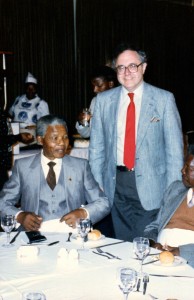
IU Vice President Emeritus and South African native Patrick O’Meara with South African revolutionary Nelson Mandela.
It’s a history that spans a wide range of academic, cultural and legal activities, perhaps none more impressive than IU’s from-the-ground-floor involvement in the establishment of Khanya College, one of South Africa’s greatest academic success stories.
In 1986, the South African Council on Higher Education (SACHED) formed Khanya College to assist talented black students who wished to pursue a university education, but, due to their disadvantages, were having difficulty obtaining entrance to South Africa’s leading universities.
That same year, IU became involved in Khanya, joining forces with SACHED to provide preparatory first-year university courses for black South Africans who demonstrated potential for pursuing an undergraduate degree. Working with faculty and tutors from South Africa, IU faculty developed undergrad courses—modeled after the university’s successful Independent Study Program—in economics, history, literature, mathematics, physics, psychology and sociology. Those same faculty graded the South African students’ major assignments and final exams, and those students who successfully completed the courses received an IU transcript. That IU transcript enabled them to gain admission to the top universities in South Africa, such as the University of Cape Town, which the IU delegation will visit later this week, and Witwatersrand University, known locally as “Wits.”
According to IU Emeritus Vice President Patrick O’Meara, a native South African who directed IU’s acclaimed African Studies Program at the time (read about his visit with Nelson Mandela), at various points more than 100 Khanya students were enrolled in these courses each year. In the first three years alone, more than 400 students completed the IU course of study. In addition, John Samuel, the head of Khanya College, visited IU on different occasions. Former IU President Thomas Ehrlich went to Khanya College in 1990, and IU faculty members and a number of Khanya faculty and administrators also made reciprocal site visits.
By the mid 1990s, IU had sufficiently trained Khanya faculty and staff, so that their South African colleagues could take over the college’s operations. Khanya College still exists today, though its mission has changed since the end of apartheid, South Africa’s national system of racial segregation that began in 1948 and wasn’t officially abolished until 1990. Today, the college contributes to the strengthening of community-based organizations, unions and non-governmental organizations with programs and other activities to foster social change and development.
Despite phasing out its participation in Khanya College, IU continued its involvement in South African education in the years to follow. Almost immediately after the end of apartheid, IU and Wits launched an initiative to improve the retention of Wits’ black South African students. As part of the initiative, which was funded for three years (1992-94) by the U.S. Information Agency’s University Affiliations Program, IU made available opportunities and programs for South African professionals in such areas as counseling, guidance and skills-learning.
Helping to address a great need in South Africa for skilled professionals with experience in writing laws, IU spearheaded the creation of the Legislative Drafting Program for South Africa in partnership with the University of Pretoria, which the IU delegation visited yesterday in an effort to re-ignite collaborative efforts between the two institutions. The project helped train more than 70 mid-level professionals over a three-year program that included service-learning training in South Africa; internships in the U.S.; video-conferencing technology for lectures and consultations; professional visits to Washington, D.C., for South African trainers involved in the certificate program; and the establishment of a consulting network of Indiana academic and legislative professionals.
In the mid-to-late 1990s, IU ran two hugely successful internship programs, including a regional internship program that brought two dozen mid-career professionals to the U.S. from the countries of Zimbabwe, Botswana and Malawi for eight-week internships. Through the other program, IU placed more than 200 professionals from South Africa in arts, business, education, government, law, media, public health and social service internships in cities all across the U.S.
IU’s political and cultural connections to South Africa run especially deep. On our way into Cape Town, I couldn’t help but notice road signs for the Helen Suzman Boulevard, one of two newly renamed boulevards in the city (the other is for Nelson Mandela). An anti-apartheid activist and member of the South African parliament, Suzman, who died in 2009, visited IU Bloomington on three occasions, and, in 1992, served as a distinguished citizen fellow at the IU Institute for Advanced Study. That same year, she was IU Bloomington’s commencement speaker and received an honorary doctorate.
The Nadine Gordimer collection in the IU Lilly Library consists of the papers of the acclaimed South African writer and winner of the 1991 Nobel Prize in Literature. The collection of 6,700 items includes correspondence with her colleagues, literary agents and publishers, and with magazines in which many of her short stories first appeared. It also features draft and final versions of her stories, articles, book reviews, novels, short story collections, speeches and story ideas, as well as a diary Gordimer kept when she was 11. Additionally, the Lilly Library houses a collection of 1,200 items relating to the distinguished South African playwright Athol Fugard.
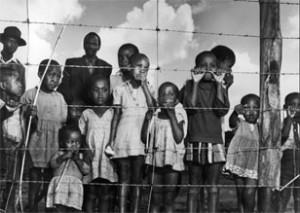
A new exhibition at IU Bloomington’s Mathers Museum of World Cultures will feature rarely seen apartheid-era images by famed “Life” photographer Margaret Bourke-White.
IU’s Black Film Center/Archive features much of the life’s work of Peter Davis, including his unique film records of South Africa before the end of apartheid. Among the nearly 2,000 reels and 40 boxes of notes, research, photographs and outtake stills are materials related to “White Laager,” a film on the history of the Afrikaner people, “Generations of Resistance,” a film on African nationalism, and two documentaries on Nelson and Winnie Mandela.
Finally, I’m most excited about an upcoming exhibition I had a chance to quickly preview the day before leaving Bloomington for South Africa. The exhibition, which will be on display next month and through the fall semester at the Mathers Museum of World Cultures, will feature rarely seen apartheid-era photos by famed “Life” photographer Margaret Bourke-White. Curated by IU associate professor of history Alex Lichtenstein, the exhibition showcases some striking, never-before-seen photographs Bourke-White took during a visit to South Africa in 1950. Following a semester in Bloomington, it will travel, in 2014, to the Bensusan Museum of Photography, Museum Africa, in Johannesburg and the Michaelis Galleries at the University of Cape Town.
Conveniently, the exhibition will open (Sept. 6) just as the IU delegation is returning from its two weeks in Africa, making it one more necessary South African-related stop on an already amazing journey through IU’s deep-rooted connections to this dynamic part of the world.
Tags: Alex Lichtenstein, apartheid, Athol Fugard, Cape Town, GIBS, Gordon Institute of Business Science, Helen Suzman, IU African Studies Program, IU Black Film Center/Archive, IU Lilly Library, Johannesburg, Khanya College, Legislative Drafting Program for South Africa, Margaret Bourke-White, Mathers Museum of World Cultures, Nadine Gordimer, Patrick O'Meara, Peter Davis, SACHED, South Africa, University of Cape Town, University of Pretoria, Wits, Witwatersrand University
A big day in Pretoria
There’s big, and then there’s Africa.
But don’t take my word for it.

An online map reflecting the “true size of Africa.” Click on the image to make it larger. (And note the U.S.)
Fittingly, size has, in large part (no pun intended) driven many of the conversations over the past two days of meetings — both yesterday at the Gordon Institute of Business Science in Johannesburg and today at GIBS’ parent institution, the University of Pretoria, which Indiana University has had a relationship with for more than a decade.
Similar in size and scope to IU’s Bloomington campus, UP, with about 45,000 students — not counting another 18,000 or so enrolled in its distance education programs — is one of the largest suppliers of high-level skills to the African economy, addressing the nation’s growing need for graduates in teaching and technology, science and engineering, and several other key development areas. In addition, its business school is thriving, as members of the IU delegation learned yesterday. In just over a decade, GIBS has risen to become Africa’s top training ground for executives and entrepreneurs.
Still, UP knows it has room to grow, which is why it has launched a major strategic initiative — UP 2025 — designed to position the university as the leading “research-intensive” university in Africa and elevate its stature in the larger global marketplace. It’s also what makes UP a sound strategic partner for IU, which possesses a bounty of teaching, learning and research resources that both complement UP’s mission and suggest strong potential for global growth opportunities for students back home in Indiana.
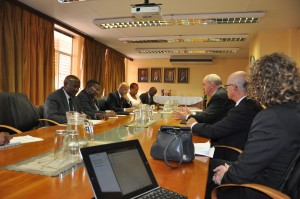
IU President Michael A. McRobbie and Vice President for International Affairs David Zaret meet with South Africa Minister of Higher Education and Training Blade Nzimande (second from left).
As IU President Michael A. McRobbie repeatedly stressed during a daylong series of meetings at Pretoria, IU has been cornering the market for years in the teaching of African languages — to the remarkable tune of 50 to 60 African languages in recent years. Those languages include everything from Akan, which is spoken mainly in Ghana and also in the Ivory Coast (where it is referred to as Abron), to Zulu, which is spoken in South Africa but can also be understood by people in Zimbabwe, Botswana, Swaziland and Lesotho.
McRobbie was also keen to note that IU provides instruction in seven of South Africa’s 11 official languages (and eight of 11 if you count English). Upon hearing about IU’s language prowess, and after learning about the university’s considerable information technology resources, Irma Eloff, dean of the faculty of education at UP, nearly leapt from her seat. “IT and languages, I’m impressed!” Eloff said, eliciting hearty laughter from her Hoosier guests. Eloff then turned serious as she surveyed the emerging African markets that UP seeks to better serve. “We simply cannot have a country where there are so many different languages spoken but where we cannot provide anyone to teach those languages.”
When the topic of discussion transitioned off languages and into the areas of economics, health sciences, the humanities and informatics, McRobbie’s message was almost always the same: IU has considerable talent, tools and resources to engage in strategic collaborations that provide students with an international dimension to their education. That international dimension is essential, he continued, to students’ success in today’s 21st-century global marketplace.
The day concluded with two important meetings. First, McRobbie and IU Vice President David Zaret spearheaded a productive discussion with South Africa Minister of Higher Education and Training Blade Nzimande, who was visibly impressed upon hearing about IU’s long history of engagement in Africa. The discussion centered around opportunities for educational collaboration in South Africa in such areas as language studies and the health sciences and the possibility of IU hosting master’s and doctoral students from South Africa.
Finally, members of the IU delegation returned to UP to meet with university President Cheryl de la Rey, who, after a lengthy and focused discussion, suggested a number of logical possible partnerships between UP and IU, including in areas that both universities have sizable strengths: education, law, the health sciences and the humanities.
It was a fitting end to a big day that promised big possibilities ahead for IU on the African horizon.
Tags: Blade Nzimande, Cheryl de la Rey, David Zaret, GIBS, Gordon Institute of Business Science, Indiana University, Irma Eloff, IU, Michael McRobbie, South Africa, University of Pretoria, UP
South Africa: ‘A great lab to engage’
Collaboration. Contradiction. Challenge. Community.
It was a day to reflect on each of these four “C’s” as the Indiana University delegation took part in its first full day of activities since arriving this past weekend in Johannesburg, South Africa, beginning with an early-morning visit to the nation’s premier business school, the Gordon Institute of Business Science.
GIBS, which it is commonly referred to as, is part of the University of Pretoria, one of South Africa’s leading research, teaching and learning universities. It is situated in a beautiful greenfield campus that lies just outside the suburb of Sandton, Johannesburg’s business hub. To say the school is on the fast track to success would be a gross understatement. Established a little over a decade ago, the school is already considered the top business school for executive education in Africa. Just last year, the Financial Times ranked the GIBS executive MBA No. 1 in Africa and 60th in the world.

Gordon Institute of Business Science Dean Nick Binedell and IU President Michael A. McRobbie sign a new partnership agreement between GIBS and IU’s Kelley School of Business.
With a catchy marketing slogan (“We mean business”) and a philosophy based on — to borrow from school dean and founding director Nick Binedell — “pragmatism and a can-do model,” GIBS is seeking to build upon the rapid success of its executive education program while fostering a well-functioning business community in a country continually challenged by the tension between its well-documented history and a future filled with potential opportunity. Indeed, both history and opportunity are reflected in GIBS’ mission: to be a business school for and from the country, one that offers a learning environment for anyone with the ideas and innovations to make an impact in South Africa, whether he or she be a successful company chairman or a 17-year-old with the energy and drive to tackle the country’s most pressing challenges.
“This is a great lab to engage,” Binedell said.
As the morning discussions at GIBS progressed, it became increasingly clear that Binedell and his colleagues had found the ideal partner in Indiana University, which has been fostering an understanding of and appreciation for this most dynamic part of the world for more than a half-century.
As IU President Michael A. McRobbie neatly summarized, IU’s involvement in Africa has spanned a remarkable range of activities, most of which can be found in the university’s acclaimed African Studies Program, long recognized as one of the leading centers for the interdisciplinary study of Africa. The program, which celebrated its 50th anniversary in 2011, is one of 11 federally funded Title VI area studies centers in IU’s new School of Global and International Studies, the largest number of such centers anywhere in the United States. The program offers more African languages than any other U.S. college or university, as well as a wide spectrum of academic offerings that includes African art, film, folklore, history, literature, music, public health and more.
Since the inception of the African Studies Program, IU has provided instruction in 52 African languages. The university regularly teaches Akan/Twi, Arabic, Bambara, Swahili, Wolof, Yoruba and Zulu, from the elementary level all the way up to the most advanced levels. IU faculty have also published more books on African languages and linguistics that any other U.S. institution. In addition, the relocation of the National African Language Resource Center to IU Bloomington (IU is the only university with such a center) has served to further strengthen its position as a premier institution for the teaching of African languages.
The depth and breadth of IU’s continued involvement in African studies, its top 10 international ranking (in terms of students studying overseas and number of international students) and its strategic decision to amass all of its international expertise (including 350 faculty members) in the newly formed School of Global and International Studies, made a major impression on the GIBS executive leadership team. The GIBS team was equally struck by the level of international engagement — including in Africa — of IU’s Kelley School of Business, which, as Dean Idie Kesner explained, has placed students in specially designed overseas studies programs in Egypt, Ghana, Kenya, South Africa and Uganda.
In turn, it was easy for members of the IU delegation to be encouraged by the rapid growth of GIBS and the school’s strong desire to develop a sophisticated business infrastructure in South Africa that, in the words of one GIBS faculty member, “rewrites the literature” of an Africa of famine and war and introduces the world to a diverse, dynamic economy energized by increasing intellectual activity.
Demonstrating a shared commitment to adding to South Africa’s intellectual and social capital, the leaders from IU and GIBS concluded the morning meetings by inking a new, formal partnership agreement that calls for, among other collaborative activities, the sharing of faculty expertise, collaborative research projects and, most importantly, future study abroad opportunities for students from both institutions.
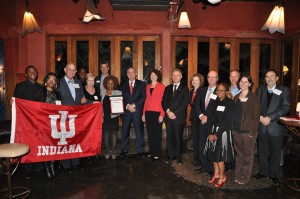
IU President McRobbie and members of the IU delegation pose with the university’s first South African alumni chapter.
After the signing of the formal agreement, members of the IU delegation were given a memorable opportunity to tour the Diepsloot settlement, which GIBS officials say they are using as a “learning lab” that is intended to provide students with a better understanding of the needs and aspirations of Africa’s “emerging less poor” and to encourage them to pursue informed business ideas that will improve the quality of life within the local community.
Crowded, noisy, dusty Diepsloot, where half the total population (400,000, living in a 5-square-kilometer area) are unemployed, came in clear contrast to the openness and order of the GIBS campus and provided a first-hand glimpse of South Africa’s complexities and contradictions. Yet it was equally striking how friendly and forthright members of the township were, as they enthusiastically welcomed members of the IU delegation into their shops and, in one instance, their family home.
Finally, a busy and diverse day concluded with community-building of a different sort: the establishment of IU’s first alumni chapter in South Africa, led by founding chapter president Nolutho Diko, who spoke glowingly and movingly about IU and what the university has meant to her and her family. Her remarks were a fitting end to a first day of fostering new friendships, furthering IU’s traditions of international education and engagement, and offering a measure of what IU will seek to accomplish with its global partners, like GIBS, in the years to come.
Tags: African Studies Program, GIBS, Gordon Institute of Business Science, Idie Kesner, Indiana University, IU Alumni Association, Johannesburg, Kelley School of Business, Michael McRobbie, Nick Binedell, Nolutho Diko, School of Global and International Studies, South Africa, University of Pretoria


